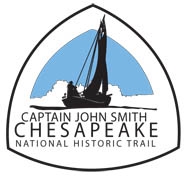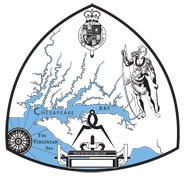

Come on a journey to remember and commemorate the history and
travels of Captain John
Smith!
Over four
hundred years ago, Englishman John Smith and a small crew set out
in an open boat to explore the Chesapeake Bay. Between 1607 and
1609 Smith mapped and documented nearly 3,000 miles of the Bay and
its rivers. Along the way he visited many thriving American Indians
communities and gathered information about this “fruitful and
delightsome land.” In December 2006 the U.S. Congress
designated the routes of Smith’s explorations of the
Chesapeake as a national historic trail—the first national
water trail.
Are you ready
to follow in the wake of Captain John Smith? Visit sites along the
National Historic Trail and learn about the native cultures and the
natural environment of the 17th-century Chesapeake through the
Captain John Smith Chesapeake Geotrail. The Trail provides
opportunities for you to experience the Bay through the routes and
places associated with Smith’s explorations. Caches will be
located in museums, refuges, parks, and towns in Virginia, Maryland
and Delaware along the rivers and creeks that Smith and his crew
explored four centuries
ago.
The Captain
John Smith (CJS) Geotrail launched June 4, 2011 with over 40 caches
within Maryland, Virginia and Delaware. A trackable geo coin will
be awarded to the first 400 geocachers, while supplies last, for
locating at least 15 CJS caches. To be eligible for the coin,
geocachers must download a passport from either the CJS Geotrail or Maryland Geocaching Society website.
Geocachers must find and log at least 15 finds, record the code
word from each cache on their passport and post a picture of
themselve at each cache location. After discovering the 15 required
caches, geocachers may have thier passports validated in person or
via mail at the National Park Service, Chesapeake Bay Office,
located at 410 Severn Ave, Suite 314, Annapolis, MD 21403. Please
refer to the passport for complete validation instructions.
Participating in the CJS geotrail is fun and we hope that many
people join in. However, it is not a requirement for logging your
find on this cache once you find the
container.

The final to this puzzle cache is a Lock & Lock stocked with a
variety of items. This puzzle cache is placed outside of the fee
area for the museum. However, the cache is only available from 9:00
a.m. to 5:00 p.m. daily. Please be respectful of the environment,
surrounding animal habitat, and all park rules. Please do not
attempt this cache at night and refer to the museum website for
updated information.
The posted coordinates are to the door of the Virginia Living
Museum. Inside the lobby, one will find a large historical map. On
the upper left of the map, the mapper added a mileage chart. Find
four mileages on the chart and plug them into the following
algebraic expressions to get the minutes of the latitude and
longitude of the actual hide. Since we are still on VLM property in
Newport News, 37 minutes north and 76 minutes west are
givens.
A = the distance from Williamsburg to Delamar
B = the distance from Williamsburg to Port Royal
C = the distance from Fredericksburg to Port Royal
D = the distance from Fredericksburg to Port du Quesne
The minutes of latitude are .014D + .011A
The minutes of longitude are .293B + .075C
The Virginia Living Museum, located in Newport News, houses a wide
array of interactive exhibits that encompass all the
Virginia’s geographic regions. Visitors can walk through
recreated environments, including a cypress swamp and a limestone
cave, to learn about the complex interaction of plants, animals,
and the environment, whether in the Piedmont or the Blue Ridge
Mountains. From tanks of fish, turtles, and frogs to two-story
enclosures with various free-flying birds, from exhibits on geology
to a planetarium, there is plenty to educate and to
entertain.
The Coastal Plain exhibit, in particular, will be of interest to
those looking to learn more about the environment John Smith and
the English colonists encountered when they first arrived in the
early 17th century. Visitors can observe the once-plentiful
sturgeon, upon which the local Indians feasted, as well as perch,
bass, turtles, and shellfish. Learn about how the Chesapeake Bay,
“the world’s richest nursery,” has changed since
the arrival of Europeans, including how development and pollution
have devastated wildlife. For example, when the colonists arrived,
oysters “lay thick as stones” according to contemporary
observers, and were able to filter the massive Bay in a few days.
Now, with the oyster population reduced by 98%, that process would
take months.
The Virginia Garden exhibit showcases botanical wildlife from the
seventeenth century through the present, again demonstrating the
effect of humans on the natural environment. See native plant
species, such as seaside perennials and wax myrtle that were
present when the first settlers arrived at Jamestown. Explore flora
that was introduced to Europeans by American Indians and the plants
that helped the settlers to survive those first critical years,
including corn, blueberries and timber trees.
The garden also displays plants the colonists introduced to
Virginia’s flora (Queen Ann’s lace, dandelion and
grasses for grazing), and more recent additions such as kudzu and
purple loostrife, which have become invasive and threaten native
plant populations. The colonists also sent some native flowering
trees and shrubs to England to be used in gardens there, as part of
the exchanges of information that took place between Europe and the
Americas.

Thanks to
QOCMike for helping with this hide and to
the Maryland Geocaching Society for assisting with this
project!